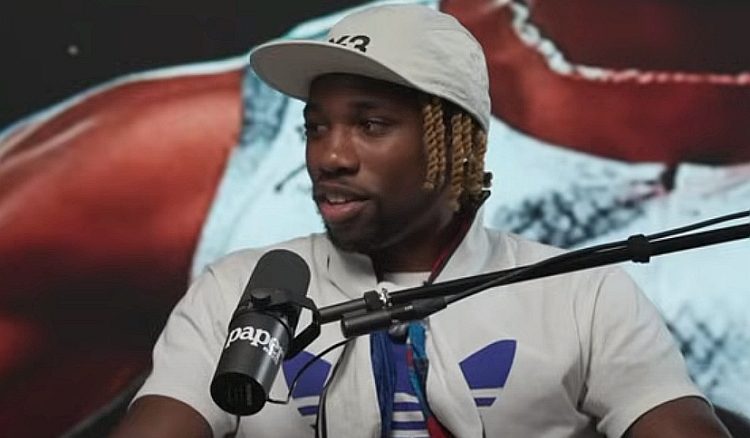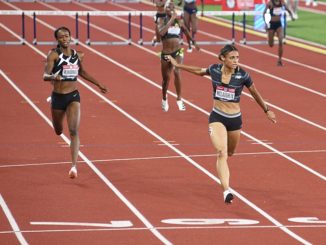
● From our sister site, TheSportsExaminer.com ●
In a fascinating, hour-plus interview with former NFL All-Pro receiver Brandon Marshall on the Paper Route by I Am Athlete video, triple sprint World Champion Noah Lyles talked about his sport, about the impact he has had and wants to have, fashion and the future.
And he and Marshall talked a lot about the business of track and field, or the lack thereof.
The video, one of a series that Marshall hosts online, was posted on 13 September (last Wednesday) and has garnered nearly 24,000 views in less than a week. Marshall asked Lyles about his comments at the Worlds men’s 200 m medal-winners news conference, where he asked why NBA teams that win the seasonal title get hats with “World Champion” on them, for a domestic league. Lyles shared that his answer was about track & field, not basketball:
“In the question, I dive into how it hurts. Usually you don’t get paid attention to [until] the Olympics, and being a track athlete living in the U.S. and trying to run and build your career, you start to get this idea that you’re only cared about for four years and you’re in a dying sport.
“But then when you go to Europe, and you’re a champion and people are taking care of you and they’re giving you hotel rooms for free and everybody in the city recognizes you like … you don’t get none of that stuff here, in the U.S. It hurts. …
“We are ready to do just as much work, and show our journey and all that, but we’re just not paid attention to. So it hurts.”
Lyles said he was not expecting the strong pushback he got from NBA players:
“And the reason why is because I’ve said this multiple times before. It’s not until now that they have paid attention, heard or even seen what’s happening.
“So, here I’ve said this multiple times and now, all of a sudden it’s blowing up. … My mission in my sport is to transcend the sport and, hopefully, take it with me. But if nobody’s hearing and seeing, it’s hard to do that.”
And then he and Marshall got into a discussion which has been going on a lot this year. Lyles explained that he wanted to use the immediate attention after the World Athletics Championships to get people interested in his next meet, the Diamond League Final:
Marshall: “What and where?”
Lyles: “I’m competing in Eugene, Oregon on September 15th.”
Marshall: “Where the hell is Eugene?”
Lyles: “In Eugene, Oregon. (Marshall laughs) Oregon Ducks, University of Oregon! (Marshall: ‘OK. Sorry.’) Hey, no, it’s OK. That leads to another issue of our sport, that we are running in these random places. …
“So, we’re running in these random places … everybody and their mama has run track & field at one point, so they’re excited, and, yeah, they just saw a meet, or Sha’Carri [Richardson] or Christian Coleman, who else won World Championships, and like ‘I want to go see them now.’
“Well, OK, we’re going to be in the U.S., but how would they know that? How would they know, if we’re not marketing or targeting the right demographics, which we really struggle with in our sport.”
Asked to explain further later, Lyles explained the backdrop – from his view – that led to today’s situation:
“The problem with the business of track & field is, there is no business. These are non-profits, and they are treated as such. Track & field started off as clubs, they were club groups. When you think of Carl Lewis’s era, they were all track & field clubs. And it just so happened that one club would have a more popular or faster athlete. So that athlete would be invited to a track meet, and eventually that athlete started saying, ‘I’m bringing in all these tickets, you need to pay me.’
“So then they started paying them. Then they started getting shoe contracts, like I’m bringing all these people in TV attention, you need to pay me. And then we just kept going, but eventually, it kind of just stopped, the growth kind of just stopped, because we were still in that club mentality.
“Everybody’s in a club, everybody only gets paid for the big moments, and that’s really what they see as what our sport is doing. But the problem is because we only get paid for those big moments, we only show up for those big moments.
“A lot of athletes [will] forego the normal part of the season to make sure they’re going to be ready – and when I say a lot of athletes, I mean the Sydney McLaughlins, the Athing Mus, the mes, the Fred Kerleys – the athletes that everyone wants to see on TV will forego to make sure they are healthy enough so that they can perform on the big stage so that they can stay and have their paycheck so they can survive.
“If you look at basketball, football, tennis, soccer, golf, they have their regular season and of course, they can all go to the Olympics, but that’s an afterthought because their sport supplies them with the ability to stay here, play, compete and still keep a normal job, a steady income. …
“It is a business at the end of the day. Technically, all track and field athletes who are paid by shoe contract are contractors: they’re not hired, they’re contractors for that brand, meaning that they can be taken on and let go very easily. So when athletes talk about unionizing and stuff like that, we can’t even technically do that, because we aren’t even employees. We got 1099s, we don’t got W-2s.
“A lot of the athletes that are in the sport can’t even think about because they’re just trying to get food on the table.”
In fact, athlete payments were made in secret for decades because of the sport’s amateur rules, which were so strict that the iconic Finnish distance runner Paavo Nurmi was disqualified before the 1932 Olympic Games in Los Angeles on the suspicion that he had received money in excess of his actual on-the-road living expenses (which wasn’t true). Approval of direct payments to athletes didn’t come until the mid-1980s.
So what now? Lyles:
“The issue comes when we are reminded that track & field is an amateur sport. There is no line for what is considered professional. A high schooler can run in a professional track meet if he knows the right person. It happens all the time, and because of that, we all have different aspirations of what we want to see change in our sport. So you’ll have the little guy who just wants more money, you’ll have the middle guy who believes he should be in more meets, and you have the higher-ups like me, who are trying to make the biggest changes on the biggest stages.
“So we all want change, but we all struggle to find how we should change it.”
Marshall commented favorably on the Atlanta City Games street meet that was held in May, and advised, “If you put the athletes first, not the fans, put the athletes first, the fans will follow, which means the money will follow.”
Lyles was also asked about the introduction of fashion into the sport, with his walk-ins, developed in conjunction with agent Mark Wetmore. Lyles said he wants to see it spread:
“Now I’m trying to get more athletes into it, and what’s funny is I will go a lot of track meets and I’ll be like ‘hey guys, we’ve had great success here; if you just give me a place to change, a vehicle and … a walkway, we can set this up at your track meet.”
The interview goes a lot of places in 66 minutes, including Lyles’ health challenges growing up, and his mind-set that has allowed him to be so good so many times. And then there’s his dream of running 9.41 in the 100 m.
~ Rich Perelman




Be the first to comment